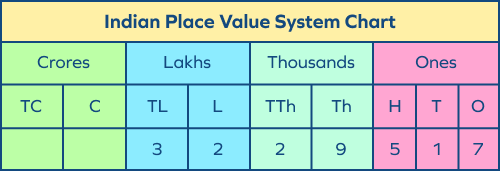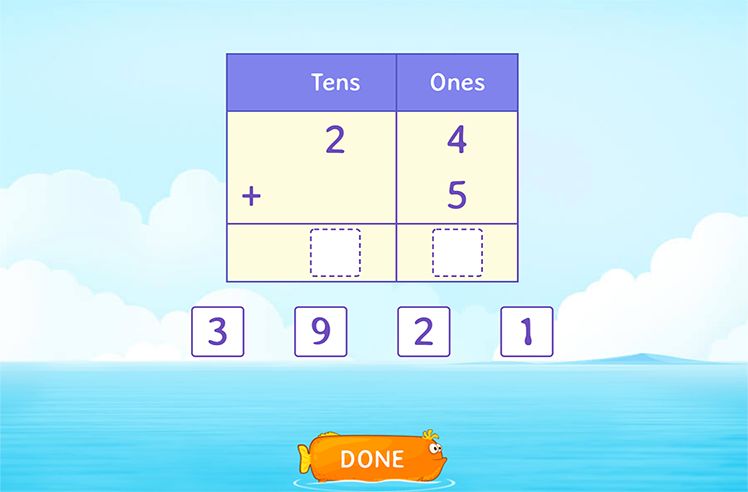- What Is the International Place Value Chart?
- Periods in the International Place Value Chart
- Difference between Indian and International Place Value Chart
- Solved Examples on International Place Value Chart
- Practice Problems on International Place Value Chart
- Frequently Asked Questions about the International Place Value Chart
What Is the International Place Value Chart?
The international place value chart in math is a table that uses the international number system to determine the value of each digit in a number based on its position.
The value of each digit in a number based on its position is called the place value. Place value refers to how much a digit is worth in relation to its position in a number.
The place value chart helps align every digit with its respective position in a number and makes it easier to find the place values. It is extremely helpful when reading, writing, and making sense of large numbers. Using a comma and a division, we separate the figures into groups to reduce confusion when reading extremely large figures.
Recommended Games
Periods in the International Place Value Chart
In the International place value system, we have three periods: ones, thousands, and millions, for the nine places from right to left. Each period contains three places.

- Ones period: This is the first period consisting of three places: ones, tens, and hundreds.
- Thousands period: This is the second period, which consists of three places: thousands, ten thousands, and hundred thousands.
- Millions period: This is the last period, which consists of three places: millions, ten millions, and hundred millions.
Recommended Worksheets
Reading and Writing Large Numbers Using the International Place Value Chart
To write large numbers using the international place value system, we separate periods using commas. So, we add commas after every three digits counting from the ones digit. Similarly, when reading large numbers, we identify the periods using the commas.
Example: The number 12345678 is written as 12,345,678 as per the International place value system.

We can read 12,345,678 as:
Twelve million, three hundred forty-five thousand, six hundred and seventy-eight.
Finding Place Values Using the International Place Value Chart
Let’s understand how the place value chart helps us find the place values of digits.
Consider an example. We have written the number 125,604,779 in the international place value chart. Each digit is aligned with its corresponding position in the chart. The place values of digits are written right below the digit.

We can write the expanded form as
125,604,779 = 100,000,000 + 20,000,000 + 5,000,000 + 600,000 + 0 + 4,000 + 700 + 70 + 9
Difference between Indian and International Place Value Chart
| Indian Place Value Chart | International Place Value Chart |
|---|---|
| There are 4 periods: ones, thousands, lakhs, and crores. | There are three periods: ones, thousands, and millions. |
| The period “lakhs” comes after “thousands.” | The period “millions” comes after “thousands.” |
| It follows the 3 : 2 : 2 system of placing commas. | It follows the 3 : 3 : 3 system of placing commas. |
| The first comma is placed after hundreds digit (three digits from the right). The next commas are placed after every two digits. | The commas are placed after every three digits counting from the digit to the far right. |
| The nine places are: ones, tens, hundreds, thousands, ten thousands, lakhs, ten lakhs, crores, and ten crores. | Nine places are:ones, tens, hundreds, thousands, ten thousands, millions, ten millions, and hundred millions. |
| The Indian place value system is followed in India, Bangladesh, and Pakistan. | International place value system is used worldwide. It is most commonly used in many countries across the world. |
Observe and compare the Indian and International place value charts to understand the differences better!
The number 3229517 is arranged in both the system charts so you can understand the place value of every digit in both the systems.
We can read it as
- Indian place value chart: Thirty-two lakh, twenty-nine thousands, five-hundred and seventeen.
- International place value chart: Three million, two-hundred twenty nine thousand, five-hundred seventeen.
Indian place value chart with example:

International place value chart with example:

Facts about International Place Value Chart
- 1 million has 6 zeros.
1 million = 1,000,000 - The fourth period in the international place value chart, that comes after millions is billions.
- 1 billion has 9 zeros.
1 billion = 1,000,000,000 - The placement of separators (commas) that defines the periods is the key difference between the Indian and international place value charts.
- 1 million = 10 lakhs
10 millions = 1 crore
1 billion = 100 crores
Conclusion
In this article, we have learned about the international place value system and chart. We also saw the difference between the Indian place value system and International place value system. Both the place value charts are important depending on their usage. Now let’s grasp more of this concept with examples and practice problems.
Solved Examples on International Place Value Chart
1. Write the place value of 4 and 7 in 73,455.
Solution:
| Thousands | Ones | ||||
| (HTh) | (TTh) | (Th) | (H) | (T) | (O) |
| 7 | 3 | 4 | 5 | 5 | |
The digit 4 is in the hundreds place. So its place value is 400.
The digit 7 is at the ten thousand’s place. So its place value is 70,000.
2. Write the following numbers in the international place value chart:
(i) 6432156
(ii) 87201593
Solution:
| Millions | Thousands | Ones | ||||||
| Hundred Millions (HM) | Ten Millions (TM) | Millions (M) | HundredThousands(HTh) | TenThousands(TTh) | Thousands (Th) | Hundreds (H) | Tens(T) | Ones (O) |
| 6 | 4 | 3 | 2 | 1 | 5 | 6 | ||
| 8 | 7 | 2 | 0 | 1 | 5 | 9 | 3 | |
3. Read and write the following numbers as per the international system.
(a) 74028952
(b) 1835762
Solution:
(a) 74028952
| Millions | Thousands | Ones | ||||||
| (HM) | (TM) | (M) | (HTh) | (TTh) | (Th) | (H) | (T) | (O) |
| 7 | 4 | 0 | 0 | 2 | 8 | 9 | 5 | 2 |
We write 74028952 as 74,028,952 and read it as “Seven-hundred forty million, twenty thousand, nine-hundred fifty two.”
(b) 1835762
| Millions | Thousands | Ones | ||||||
| (HM) | (TM) | (M) | (HTh) | (TTh) | (Th) | (H) | (T) | (O) |
| 1 | 8 | 3 | 5 | 7 | 6 | 2 | ||
We write1835762 as 1,835,762 and read it as “one million, eight hundred thirty-five thousand,
seven hundred sixty-two.”
Practice Problems on International Place Value Chart
International Place Value Chart System - Examples, Facts, FAQs
Which period does the “hundreds” place belong to?
The hundreds place belongs to the ones period.
One million = ________
One million has 6 zeros.
We can write 987654321 using the periods in the international place value chart as
We place commas after every three digits starting from the right.
Which period has the same places under both Indian and international place value systems?
Ones
Add commas according to the international place value chart to the given number: 10395784
We place commas after every three digits starting from the right.
Frequently Asked Questions about the International Place Value Chart
What is the face value of a digit?
The face value of a digit is the digit itself, irrespective of its position in the number.
For example, the face value of the digit 4 in 45785 is 4.
What is the place value of a digit?
A place value is the value of a digit in a number calculated on the basis of its position in the number.
For example, the place value of 7 in 3,743 is 700.
The place value of 7 in 7,432 is 7 thousand or 7,000.
Which period comes after million?
Billion
Which number has the same place and face value ?
0 is the only number whose face value and place value are equal.
What is the value of 1 million as per the Indian place value chart?
10 lakh
How do you write 10 digits in the international system?
After the nine digits, we have the “billions” period, which contains three digits.




































